EccDNA formation is dependent on MMEJ, repressed by c-NHEJ pathway, and stimulated by DNA double-strand break
Preprint posted on 4 December 2020 https://www.biorxiv.org/content/10.1101/2020.12.03.410480v1
DNA double-strand breaks induce extrachromosomal circular DNA formation.
Selected by Sree Rama ChaitanyaCategories: cancer biology, cell biology, genomics, molecular biology
Context1-5
Our cells have genetic material other than linear chromosomes (like mitochondrial DNA). But recent pieces of evidence reveal the existence of free circular DNA called extrachromosomal circular DNA (eccDNA or ecDNA, also called double minutes) in normal and cancer cells. These can impel genetic variability in isogenic cells or tumors, causing intra-tumor heterogeneity to perpetuate drug-resistant colonies. ecDNA could also harbor protein-coding oncogenes or even non-canonical small RNA genes. ecDNA form when DNA breaks produce linear DNA molecules either by excision or by copying, which circularize by ligation. However, the molecular mechanisms and pathways that lead to the formation of ecDNA are not clear. Therefore, the authors of the current preprint set forward to investigate the possible DNA repair pathways that contribute to ecDNA biogenesis.
General strategy (fig.1). The authors evaluated previously identified ecDNA molecules in human (U2OS, 293) and chicken (DT40) cells using inverse quantitative PCR (check supplementary tables of the preprint for the list of ecDNAs used in this study). They purify the circles from cell lysates using commercial circular plasmid prep kits followed by extensive digestion with exonucleases to degrade any contaminating linear DNA. They designed outward-facing primers that will amplify across the junction sequence of a circle but will not produce an amplicon from linear DNA. They used mitochondrial DNA as a control for normalization. In this way, they deem to achieve ecDNA specific amplicons.
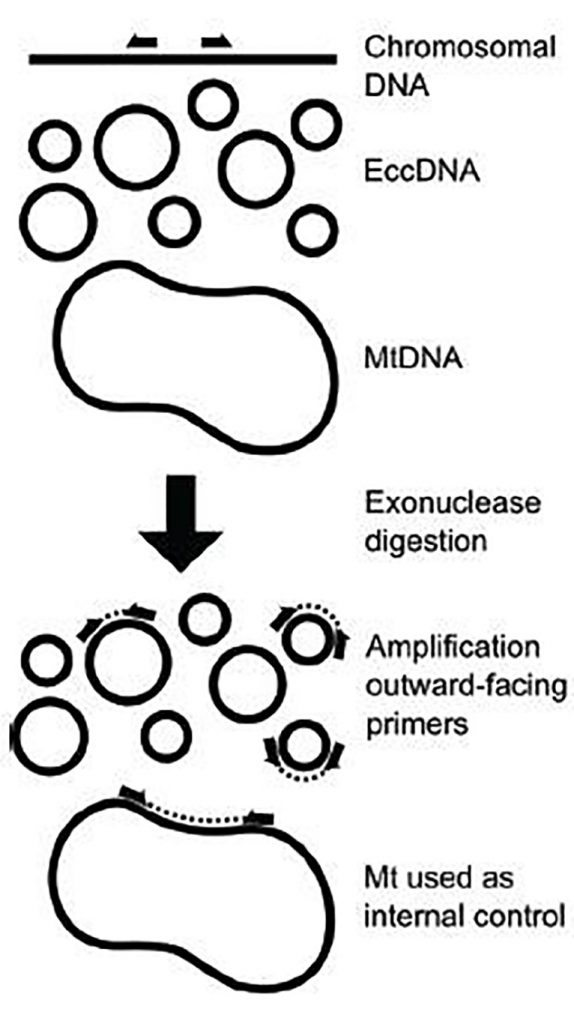
Key findings
- First, they found that 293 cells manifested a two-fold increase in ecDNAs when exposed to different exogenous sources of DNA damage (like UV, cisplatin, neocarzinostatin, etc).
- Then, they tested if one DNA double-strand break (DSB) is sufficient to induce ecDNA formation locally (fig.2). For this purpose, they induced a DSB using CRISPR at a genomic locus (Chr22:18624104). This locus usually has low levels of ecDNA and contains unique sequences. Its transcriptional output is also low to avoid any confounding effects. The guide-RNA was site-specific, and the cutting efficiency was greater than 60%. Using a set of outward-directed primers, they were able to report ecDNA molecules that span about 150-1500bp DNA adjoining the DSB-site. They were not able to detect ecDNA, at DNAs greater than1500bp from the DSB-site, suggesting ecDNA form at closer proximity to the DSB. Thus, they suggest that a single DSB is sufficient to induce ecDNA molecules in cis.
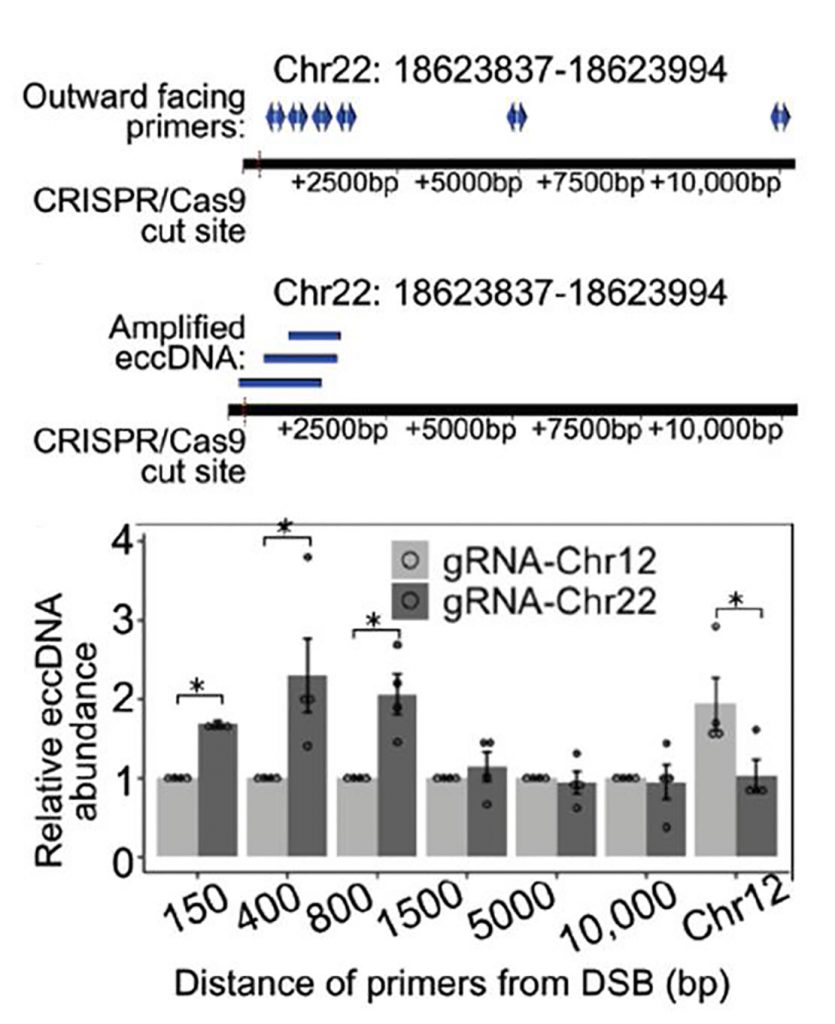
2. Diagram of induced DSBs at locus Chr22:18624104 in 293A cells and the amplification of ecDNA arising proximal to the cut site using outward-facing primers. Quantification of ecDNA isolated 48 hours after the transfection of a p413 vector containing CAS9 and a gRNA sequence or a gRNA sequence targeting Chr22:18624104 or Chr12:117100086. - To dissect the DNA repair pathways involved in ecDNA biology, they used isogenic cell lines lacking DNA repair genes (or chemical inhibitors of DNA repair enzymes) (fig.3). They broadly classified the genes as the ones that can repair broken DNA through end-resection or not. In these lines, they demonstrate that depletion of canonical non-homologous end joining (c-NHEJ) genes induced ecDNA molecules in different cell lines. Additionally, cells depleted of gene products that are part of the end-resection pathway (like NBS1) manifested lower ecDNA molecules. Moreover, cells lacking proteins of the microhomology-mediated end joining (MMEJ) and mismatch repair (MMR) pathways manifested lower levels of ecDNA. While proteins of base excision repair pathway (BER) (like FEN1, APE1, etc.) do not seem to impact ecDNA levels, inhibition of poly (ADP-ribose) polymerases (PARPs), a common component of MMEJ and BER pathways reduced ecDNA levels. Additionally, chemical inhibition of RAD52 (single-strand annealing, SSA) and ERCC1-XPF (nucleotide excision repair, NER) did not impact ecDNA levels significantly.
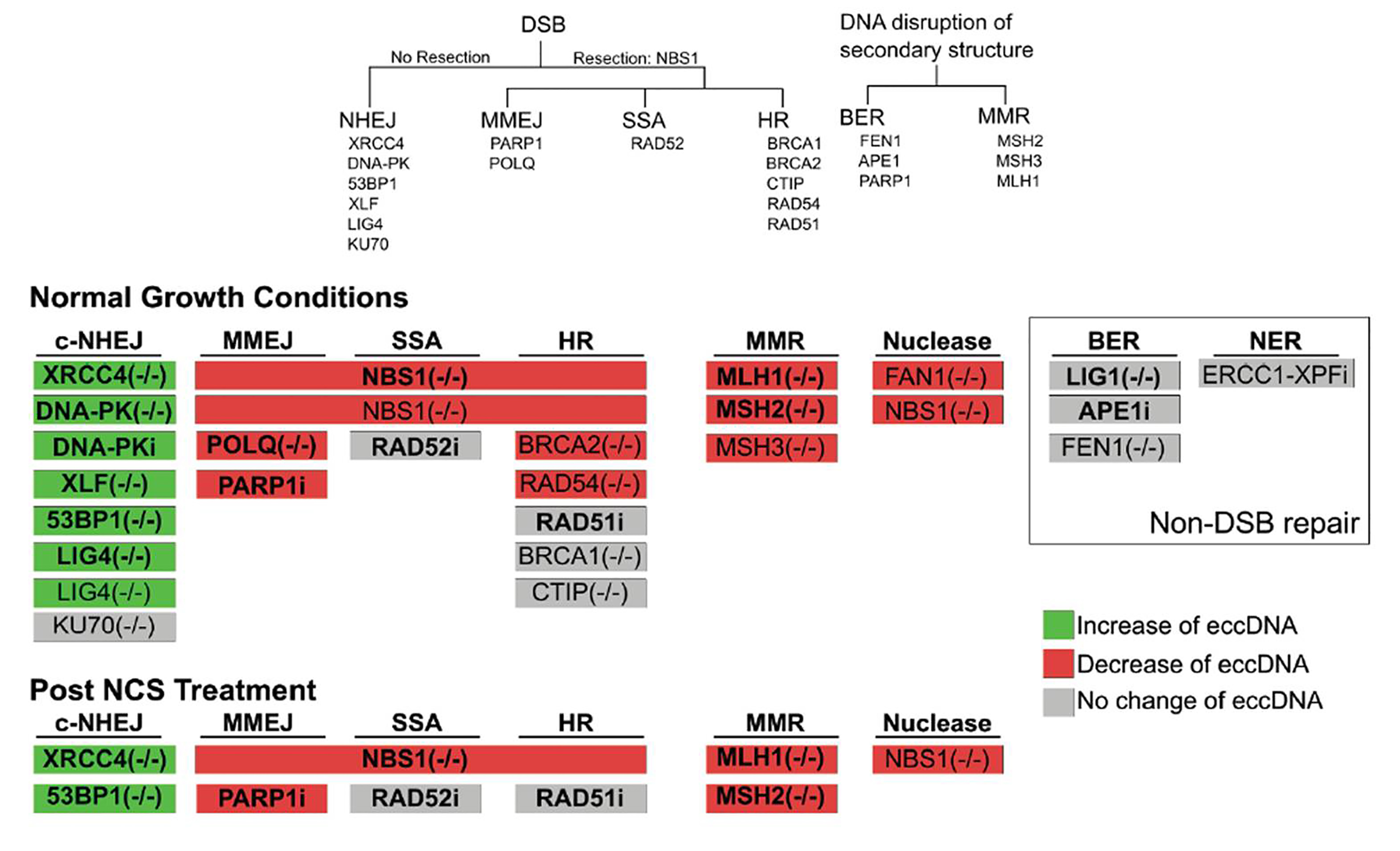
3. DNA repair genes knocked-out or inhibited in this work. Graphical summary of whether mutants or inhibitors or a given repair pathway increased (green) or decreased (red) ecDNA levels. - Interestingly, the authors found a mixed impact on ecDNA levels when proteins of the homologous recombination pathway (HR) were down-regulated. Here, except for RAD54 and BRCA1, other HR proteins (RAD51, BRCA2, and CTIP) did not show a significant reduction in ecDNA levels. Notably, when they induced DSBs chemically (using neocarzinostatin), c-NHEJ deficient cells manifested higher levels of ecDNA, and MMEJ deficient cells had lower levels of ecDNAs. Altogether, the authors suggest that while MMEJ (and resection) supports, c-NHEJ could thwart ecDNA formation (fig.3).
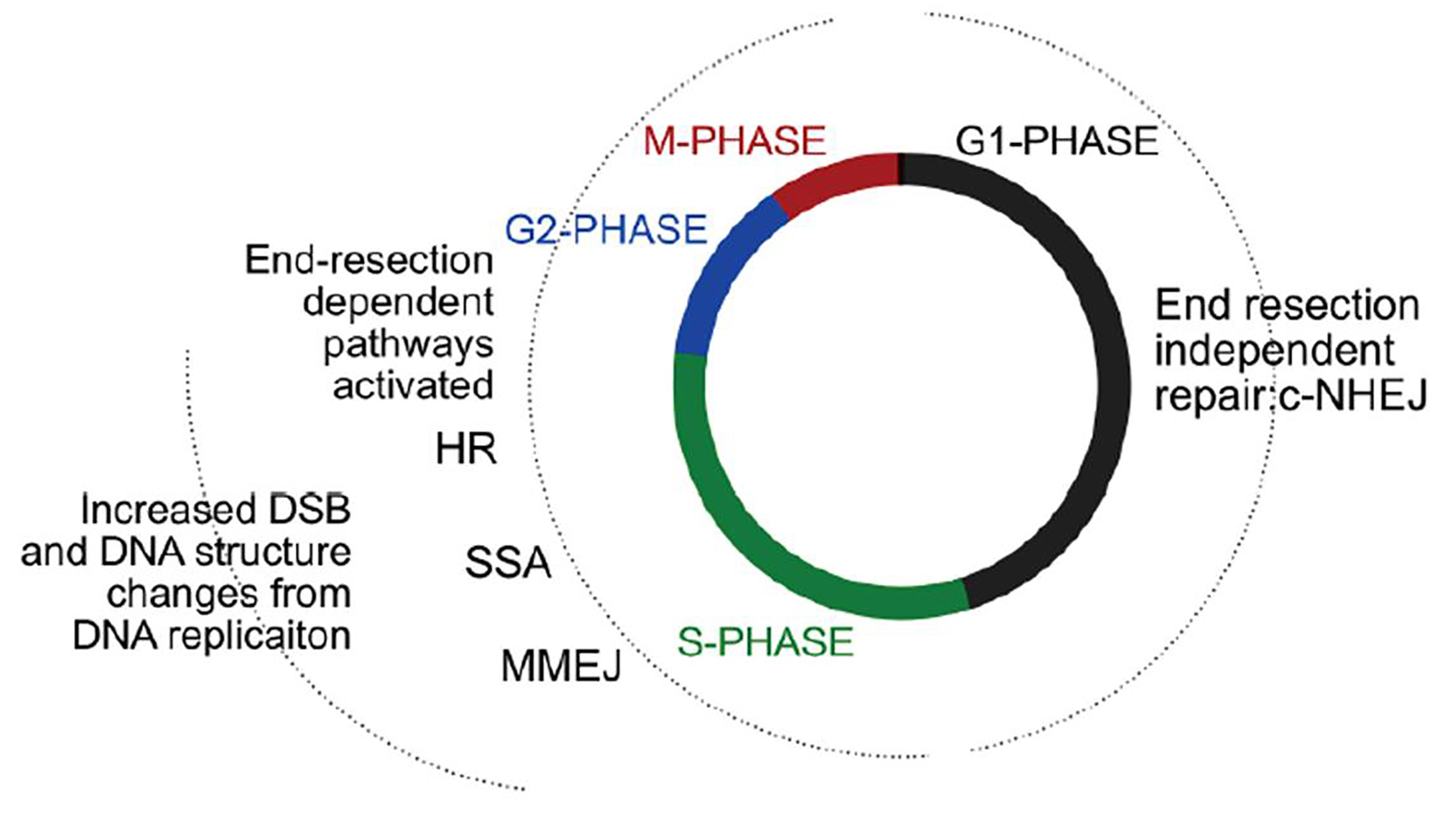
4. End-resection-independent pathway of repair is active in G1, while end-resection (and homology) dependent repair is more active in S and G2. - Repair of damaged DNA is very much dependent on cell cycle stages. While c-NHEJ can occur in all phases of the cell cycle, alternative-NHEJ pathways that favor end-resection (like MMEJ, HR) preferentially occur during the replicating S phase (fig.4). Hence, the authors chemically arrested the cells (using hydroxyurea and nocodazole) and evaluated ecDNA levels in different cell cycle stages. They show that ecDNA tends to accumulate in cells during S-, G2-, and M-phases. Also, inhibition of replication (using aphidicolin) reduced ecDNA levels, reinforcing that ecDNA tend to form during S/G2 phases. But intriguingly, ecDNA levels dropped when cells re-enter the G1-phase.
Perspective
Genome instability is a hallmark of cancer. However, the aftermath of drugs targeted to DNA repair pathways is often catastrophic on healthy cells, and severely impacts an individual’s recovery. The equation is complex, and solving the cancer puzzle is not just simply summing the parts. Hence, it is important to understand how genome instability specifically drives tumor progression and triggers intra-tumor heterogeneity.
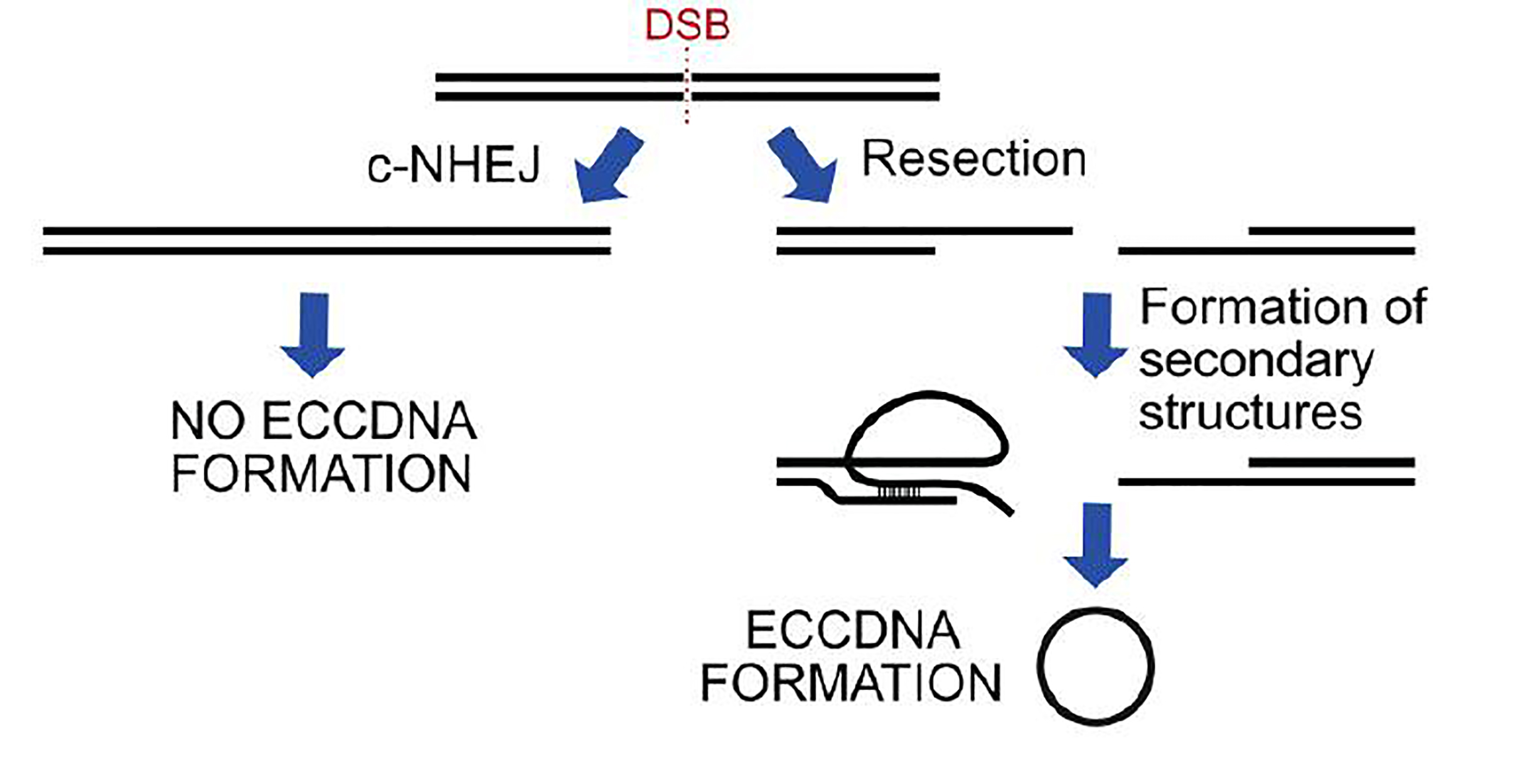
Here, the authors propose that even a single DSB is sufficient to trigger ecDNA in replicating cells (fig.5). ecDNA could be a way out for cancer cells to make extra copies of oncogenes or drug-resistance genes. This warrants a better understanding of the outcomes of genome instability so that we can develop smarter therapeutic combinations to promote faster and relapse-free recovery.
Acknowledgments: I am thankful to all the authors for their support, and Anindya Dutta for taking the time to comment on the preLight and replying promptly.
All figures and figure legends of this preLight are taken and modified directly from Paulsen et. al., 2020 under a CC-BY 4.0 international license.
References
- https://doi.org/10.1016/j.tig.2017.12.010
- https://doi.org/10.1016/j.annonc.2020.03.303
- https://doi.org/10.1038/s41568-019-0128-6
- https://dx.doi.org/10.1093%2Fnar%2Fgkz155
- https://dx.doi.org/10.1126%2Fsciadv.aba2489
- https://dx.doi.org/10.3389%2Ffmolb.2020.00024
- https://doi.org/10.1016/j.celrep.2015.05.020
Posted on: 5 January 2021
doi: https://doi.org/10.1242/prelights.26479
Read preprintSign up to customise the site to your preferences and to receive alerts
Register hereAlso in the cancer biology category:
Spatial transcriptomics elucidates medulla niche supporting germinal center response in myasthenia gravis thymoma
Invasion of glioma cells through confined space requires membrane tension regulation and mechano-electrical coupling via Plexin-B2
Modeling transcriptional profiles of gene perturbation with a deep neural network
Also in the cell biology category:
Fetal brain response to maternal inflammation requires microglia
Alteration of long and short-term hematopoietic stem cell ratio causes myeloid-biased hematopoiesis
Clusters of lineage-specific genes are anchored by ZNF274 in repressive perinucleolar compartments
Also in the genomics category:
Temporal constraints on enhancer usage shape the regulation of limb gene transcription
Transcriptional profiling of human brain cortex identifies novel lncRNA-mediated networks dysregulated in amyotrophic lateral sclerosis
A long non-coding RNA at the cortex locus controls adaptive colouration in butterflies
AND
The ivory lncRNA regulates seasonal color patterns in buckeye butterflies
AND
A micro-RNA drives a 100-million-year adaptive evolution of melanic patterns in butterflies and moths
Also in the molecular biology category:
Fetal brain response to maternal inflammation requires microglia
Clusters of lineage-specific genes are anchored by ZNF274 in repressive perinucleolar compartments
Nanos2+ cells give rise to germline and somatic lineages in the sea anemone Nematostella vectensis
preLists in the cancer biology category:
BSCB-Biochemical Society 2024 Cell Migration meeting
This preList features preprints that were discussed and presented during the BSCB-Biochemical Society 2024 Cell Migration meeting in Birmingham, UK in April 2024. Kindly put together by Sara Morais da Silva, Reviews Editor at Journal of Cell Science.
| List by | Reinier Prosee |
CSHL 87th Symposium: Stem Cells
Preprints mentioned by speakers at the #CSHLsymp23
| List by | Alex Eve |
Journal of Cell Science meeting ‘Imaging Cell Dynamics’
This preList highlights the preprints discussed at the JCS meeting 'Imaging Cell Dynamics'. The meeting was held from 14 - 17 May 2023 in Lisbon, Portugal and was organised by Erika Holzbaur, Jennifer Lippincott-Schwartz, Rob Parton and Michael Way.
| List by | Helen Zenner |
CellBio 2022 – An ASCB/EMBO Meeting
This preLists features preprints that were discussed and presented during the CellBio 2022 meeting in Washington, DC in December 2022.
| List by | Nadja Hümpfer et al. |
Fibroblasts
The advances in fibroblast biology preList explores the recent discoveries and preprints of the fibroblast world. Get ready to immerse yourself with this list created for fibroblasts aficionados and lovers, and beyond. Here, my goal is to include preprints of fibroblast biology, heterogeneity, fate, extracellular matrix, behavior, topography, single-cell atlases, spatial transcriptomics, and their matrix!
| List by | Osvaldo Contreras |
Single Cell Biology 2020
A list of preprints mentioned at the Wellcome Genome Campus Single Cell Biology 2020 meeting.
| List by | Alex Eve |
ASCB EMBO Annual Meeting 2019
A collection of preprints presented at the 2019 ASCB EMBO Meeting in Washington, DC (December 7-11)
| List by | Madhuja Samaddar et al. |
Lung Disease and Regeneration
This preprint list compiles highlights from the field of lung biology.
| List by | Rob Hynds |
Anticancer agents: Discovery and clinical use
Preprints that describe the discovery of anticancer agents and their clinical use. Includes both small molecules and macromolecules like biologics.
| List by | Zhang-He Goh |
Biophysical Society Annual Meeting 2019
Few of the preprints that were discussed in the recent BPS annual meeting at Baltimore, USA
| List by | Joseph Jose Thottacherry |
Also in the cell biology category:
BSCB-Biochemical Society 2024 Cell Migration meeting
This preList features preprints that were discussed and presented during the BSCB-Biochemical Society 2024 Cell Migration meeting in Birmingham, UK in April 2024. Kindly put together by Sara Morais da Silva, Reviews Editor at Journal of Cell Science.
| List by | Reinier Prosee |
‘In preprints’ from Development 2022-2023
A list of the preprints featured in Development's 'In preprints' articles between 2022-2023
| List by | Alex Eve, Katherine Brown |
preLights peer support – preprints of interest
This is a preprint repository to organise the preprints and preLights covered through the 'preLights peer support' initiative.
| List by | preLights peer support |
The Society for Developmental Biology 82nd Annual Meeting
This preList is made up of the preprints discussed during the Society for Developmental Biology 82nd Annual Meeting that took place in Chicago in July 2023.
| List by | Joyce Yu, Katherine Brown |
CSHL 87th Symposium: Stem Cells
Preprints mentioned by speakers at the #CSHLsymp23
| List by | Alex Eve |
Journal of Cell Science meeting ‘Imaging Cell Dynamics’
This preList highlights the preprints discussed at the JCS meeting 'Imaging Cell Dynamics'. The meeting was held from 14 - 17 May 2023 in Lisbon, Portugal and was organised by Erika Holzbaur, Jennifer Lippincott-Schwartz, Rob Parton and Michael Way.
| List by | Helen Zenner |
9th International Symposium on the Biology of Vertebrate Sex Determination
This preList contains preprints discussed during the 9th International Symposium on the Biology of Vertebrate Sex Determination. This conference was held in Kona, Hawaii from April 17th to 21st 2023.
| List by | Martin Estermann |
Alumni picks – preLights 5th Birthday
This preList contains preprints that were picked and highlighted by preLights Alumni - an initiative that was set up to mark preLights 5th birthday. More entries will follow throughout February and March 2023.
| List by | Sergio Menchero et al. |
CellBio 2022 – An ASCB/EMBO Meeting
This preLists features preprints that were discussed and presented during the CellBio 2022 meeting in Washington, DC in December 2022.
| List by | Nadja Hümpfer et al. |
Fibroblasts
The advances in fibroblast biology preList explores the recent discoveries and preprints of the fibroblast world. Get ready to immerse yourself with this list created for fibroblasts aficionados and lovers, and beyond. Here, my goal is to include preprints of fibroblast biology, heterogeneity, fate, extracellular matrix, behavior, topography, single-cell atlases, spatial transcriptomics, and their matrix!
| List by | Osvaldo Contreras |
EMBL Synthetic Morphogenesis: From Gene Circuits to Tissue Architecture (2021)
A list of preprints mentioned at the #EESmorphoG virtual meeting in 2021.
| List by | Alex Eve |
FENS 2020
A collection of preprints presented during the virtual meeting of the Federation of European Neuroscience Societies (FENS) in 2020
| List by | Ana Dorrego-Rivas |
Planar Cell Polarity – PCP
This preList contains preprints about the latest findings on Planar Cell Polarity (PCP) in various model organisms at the molecular, cellular and tissue levels.
| List by | Ana Dorrego-Rivas |
BioMalPar XVI: Biology and Pathology of the Malaria Parasite
[under construction] Preprints presented at the (fully virtual) EMBL BioMalPar XVI, 17-18 May 2020 #emblmalaria
| List by | Dey Lab, Samantha Seah |
1
Cell Polarity
Recent research from the field of cell polarity is summarized in this list of preprints. It comprises of studies focusing on various forms of cell polarity ranging from epithelial polarity, planar cell polarity to front-to-rear polarity.
| List by | Yamini Ravichandran |
TAGC 2020
Preprints recently presented at the virtual Allied Genetics Conference, April 22-26, 2020. #TAGC20
| List by | Maiko Kitaoka et al. |
3D Gastruloids
A curated list of preprints related to Gastruloids (in vitro models of early development obtained by 3D aggregation of embryonic cells). Updated until July 2021.
| List by | Paul Gerald L. Sanchez and Stefano Vianello |
ECFG15 – Fungal biology
Preprints presented at 15th European Conference on Fungal Genetics 17-20 February 2020 Rome
| List by | Hiral Shah |
ASCB EMBO Annual Meeting 2019
A collection of preprints presented at the 2019 ASCB EMBO Meeting in Washington, DC (December 7-11)
| List by | Madhuja Samaddar et al. |
EMBL Seeing is Believing – Imaging the Molecular Processes of Life
Preprints discussed at the 2019 edition of Seeing is Believing, at EMBL Heidelberg from the 9th-12th October 2019
| List by | Dey Lab |
Autophagy
Preprints on autophagy and lysosomal degradation and its role in neurodegeneration and disease. Includes molecular mechanisms, upstream signalling and regulation as well as studies on pharmaceutical interventions to upregulate the process.
| List by | Sandra Malmgren Hill |
Lung Disease and Regeneration
This preprint list compiles highlights from the field of lung biology.
| List by | Rob Hynds |
Cellular metabolism
A curated list of preprints related to cellular metabolism at Biorxiv by Pablo Ranea Robles from the Prelights community. Special interest on lipid metabolism, peroxisomes and mitochondria.
| List by | Pablo Ranea Robles |
BSCB/BSDB Annual Meeting 2019
Preprints presented at the BSCB/BSDB Annual Meeting 2019
| List by | Dey Lab |
MitoList
This list of preprints is focused on work expanding our knowledge on mitochondria in any organism, tissue or cell type, from the normal biology to the pathology.
| List by | Sandra Franco Iborra |
ASCB/EMBO Annual Meeting 2018
This list relates to preprints that were discussed at the recent ASCB conference.
| List by | Dey Lab, Amanda Haage |
Also in the genomics category:
BSCB-Biochemical Society 2024 Cell Migration meeting
This preList features preprints that were discussed and presented during the BSCB-Biochemical Society 2024 Cell Migration meeting in Birmingham, UK in April 2024. Kindly put together by Sara Morais da Silva, Reviews Editor at Journal of Cell Science.
| List by | Reinier Prosee |
preLights peer support – preprints of interest
This is a preprint repository to organise the preprints and preLights covered through the 'preLights peer support' initiative.
| List by | preLights peer support |
9th International Symposium on the Biology of Vertebrate Sex Determination
This preList contains preprints discussed during the 9th International Symposium on the Biology of Vertebrate Sex Determination. This conference was held in Kona, Hawaii from April 17th to 21st 2023.
| List by | Martin Estermann |
Semmelweis Symposium 2022: 40th anniversary of international medical education at Semmelweis University
This preList contains preprints discussed during the 'Semmelweis Symposium 2022' (7-9 November), organised around the 40th anniversary of international medical education at Semmelweis University covering a wide range of topics.
| List by | Nándor Lipták |
20th “Genetics Workshops in Hungary”, Szeged (25th, September)
In this annual conference, Hungarian geneticists, biochemists and biotechnologists presented their works. Link: http://group.szbk.u-szeged.hu/minikonf/archive/prg2021.pdf
| List by | Nándor Lipták |
EMBL Conference: From functional genomics to systems biology
Preprints presented at the virtual EMBL conference "from functional genomics and systems biology", 16-19 November 2020
| List by | Jesus Victorino |
TAGC 2020
Preprints recently presented at the virtual Allied Genetics Conference, April 22-26, 2020. #TAGC20
| List by | Maiko Kitaoka et al. |
Zebrafish immunology
A compilation of cutting-edge research that uses the zebrafish as a model system to elucidate novel immunological mechanisms in health and disease.
| List by | Shikha Nayar |
Also in the molecular biology category:
BSCB-Biochemical Society 2024 Cell Migration meeting
This preList features preprints that were discussed and presented during the BSCB-Biochemical Society 2024 Cell Migration meeting in Birmingham, UK in April 2024. Kindly put together by Sara Morais da Silva, Reviews Editor at Journal of Cell Science.
| List by | Reinier Prosee |
‘In preprints’ from Development 2022-2023
A list of the preprints featured in Development's 'In preprints' articles between 2022-2023
| List by | Alex Eve, Katherine Brown |
CSHL 87th Symposium: Stem Cells
Preprints mentioned by speakers at the #CSHLsymp23
| List by | Alex Eve |
9th International Symposium on the Biology of Vertebrate Sex Determination
This preList contains preprints discussed during the 9th International Symposium on the Biology of Vertebrate Sex Determination. This conference was held in Kona, Hawaii from April 17th to 21st 2023.
| List by | Martin Estermann |
Alumni picks – preLights 5th Birthday
This preList contains preprints that were picked and highlighted by preLights Alumni - an initiative that was set up to mark preLights 5th birthday. More entries will follow throughout February and March 2023.
| List by | Sergio Menchero et al. |
CellBio 2022 – An ASCB/EMBO Meeting
This preLists features preprints that were discussed and presented during the CellBio 2022 meeting in Washington, DC in December 2022.
| List by | Nadja Hümpfer et al. |
EMBL Synthetic Morphogenesis: From Gene Circuits to Tissue Architecture (2021)
A list of preprints mentioned at the #EESmorphoG virtual meeting in 2021.
| List by | Alex Eve |
FENS 2020
A collection of preprints presented during the virtual meeting of the Federation of European Neuroscience Societies (FENS) in 2020
| List by | Ana Dorrego-Rivas |
ECFG15 – Fungal biology
Preprints presented at 15th European Conference on Fungal Genetics 17-20 February 2020 Rome
| List by | Hiral Shah |
ASCB EMBO Annual Meeting 2019
A collection of preprints presented at the 2019 ASCB EMBO Meeting in Washington, DC (December 7-11)
| List by | Madhuja Samaddar et al. |
Lung Disease and Regeneration
This preprint list compiles highlights from the field of lung biology.
| List by | Rob Hynds |
MitoList
This list of preprints is focused on work expanding our knowledge on mitochondria in any organism, tissue or cell type, from the normal biology to the pathology.
| List by | Sandra Franco Iborra |











 (No Ratings Yet)
(No Ratings Yet)